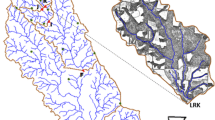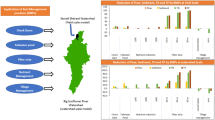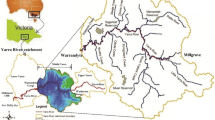Abstract
The Bosque River Watershed in Texas is facing a suite of water quality issues including excess sediment, nutrient, and bacteria. The sources of the pollutants are improperly managed cropland and grazing land, dairy manure application, and effluent discharge from wastewater treatment facilities. Several best management practices (BMPs) have been proposed for pollution reduction and watershed protection. The overall objectives of this study were to demonstrate a modeling approach using Soil and Water Assessment Tool (SWAT) model to simulate various BMPs and assess their long-term impacts on sediment and nutrient loads at different spatial levels. The SWAT model was calibrated and validated for long-term annual and monthly flows at Valley Mills and for monthly sediment, total nitrogen (TN) and total phosphorus (TP) at Hico and Valley Mills monitoring locations. The BMPs including streambank stabilization, gully plugs, recharge structures, conservation tillage, terraces, contour farming, manure incorporation, filter strips, and PL-566 reservoirs were simulated in the watershed areas that met the respective practice’s specific criteria for implementation. These BMPs were represented in the pre- and post-conditions by modifying one or more channel parameters (channel cover, erodibility, Manning’s n), curve number (CN), support practice factor (P-factor), filter strip width, and tillage parameters (mixing efficiency, mixing depth). The BMPs were simulated individually and the resulting Hydrologic Response Units (HRUs), subwatershed, and watershed level impacts were quantified for each BMP. Sensitivity of model output values to input parameters used to represent the BMPs was also evaluated. Implementing individual BMPs reduced sediment loads from 3% to 37% and TN loads from 1% to 24% at the watershed outlet; however, the changes in TP loads ranged from 3% increase to 30% decrease. Higher reductions were simulated at the subwatershed and HRU levels. Among the parameters analyzed for sensitivity, P-factor and CN were most sensitive followed by Manning’s n. The TN and TP outputs were not sensitive to channel cover. This study showed that the SWAT modeling approach could be used to simulate and assess the effectiveness of agricultural best management practices.
Similar content being viewed by others
References
Arabi M, Govindaraju RS, Hantush MM (2007) A probabilistic approach for analysis of uncertainty in the evaluation of watershed management practices. J Hydrol 333(2–4):459–471
Arabi M, Govindaraju RS, Hantush MM, Engel BA (2006) Role of watershed subdivision on modeling the effectiveness of best management practices with SWAT. J Am Water Resour Assoc 42(2):513–528
Arnold JG, Allen PM (1999) Automated methods for estimating baseflow and ground water recharge from streamflow records. J Am Water Resour Assoc 35(2):411–424
Arnold JG, Allen PM, Muttiah RS, Bernhardt G (1995) Automated baseflow separation and recession analysis techniques. Ground Water 33(6):1010–1018
Arnold JG, Srinivasan R, Muttiah RS, Williams JR (1998) Large area hydrologic modeling and assessment Part I: model development. J Am Water Resour Assoc 34(1):73–89
Bagnold RA (1977) Bedload transport in natural rivers. Water Resour Res 13(20):303–312
Baird RW (1964) Sediment yields from Blackland watersheds. Trans ASAE 7(4):454–465
Bingner RL, Garbrecht J, Arnold JG, Srinivasan R (1997) Effect of watershed subdivision on simulation runoff and fine sediment yield. Trans ASAE 40(5):1329–1335
Bracmort KS, Arabi M, Frankenberger JR, Engel BA, Arnold JG (2006) Modeling long-term water quality impact of structural BMPs. Trans ASAE 49(2):367–374
Brown LC, Barnwell TO Jr (1987) The enhanced water quality models QUAL2E and QUAL2E-UNCAS documentation and user manual. EPA document EPA/600/3-87/007. USEPA, Athens, GA
Chen E, Mackay DS (2004) Effects of distribution-based parameter aggregation on a spatially distributed agricultural nonpoint-source pollution model. J Hydrol 295(1–4):211–224
Chow VT (1959) Open-channel hydraulics. McGraw-Hill, New York, p 112
Cotter AS, Chaubey I, Costello TA, Soerens TS, Nelson MA (2003) Water quality model output uncertainty as affected by spatial resolution of input data. J Am Water Resour Assoc 39(4):977–986
Cullen AC, Frey HC (1999) Probabilistic techniques in exposure assessment. Plenum, New York
Dalzell BJ, Gowda PH, Mulla DJ (2004) Modeling sediment and phosphorus losses in an agricultural watershed to meet TMDLs. J Am Water Resour Assoc 40(2):533–543
Di Luzio M, Srinivasan R, Arnold JG (2004a) A GIS-coupled hydrological model system for the water assessment of agricultural nonpoint and point sources of pollution. Trans GIS 8(1):113–136
Di Luzio M, Arnold JG, Srinivasan R (2004b) Integration of SSURGO maps and soil parameters within a geographic information system and nonpoint source pollution model system. J Soil Water Conserv 59(4):123–133
DiLuzio M, Arnold JG, Srinivasan R (2005) Effect of GIS data quality on small watershed streamflow and sediment simulations. Hydrol Process 19(3):629–650
Eckhardt K, Breuer L, Frede HG (2003) Parameter uncertainty and the significance of simulated land use change effects. J Hydrol 273:164–176
FitzHugh TW, Mackay DS (2000) Impacts of input parameter spatial aggregation on an agricultural nonpoint source pollution model. J Hydrol 236:35–53
Gaddis EJB, Voinov A (2009) Spatially explicit modeling of land use specific phosphorus transport pathways to improve TMDL load estimates and implementation planning. Water Resour Manag. doi:10.1007/s11269-009-9517-z
Gassman PW, Reyers MR, Green CH, Arnold JG (2007) The soil and water assessment tool: historical development, applications, and future research directions. Transaction of the American Society of Agricultural and Biological Engineers 50(4):1211–1250
Gassman PW, Osei E, Saleh A, Rodecap J, Norvell S, Williams JR (2006) Alternative practices for sediment and nutrient loss control on livestock farms in northeast Iowa. Agriculture Ecosystems and Environment 117:135–144
Gitau MW, Gburek WJ, Jarrett AR (2005) A tool for estimating best management practice effectiveness for phosphorus pollution control. J Soil Water Conserv 60(1):1–10
Green WH, Ampt GA (1911) Studies on soil physics: 1. The flow of air and water through soils. J Agric Sci 4:11–24
Hanzlik JE, Munster CL, McFarland A, Vietor DM, White RH (2004) GIS analysis to identify turfgrass SOD production sites for phosphorus removal. Trans ASAE 47(2):453–461
Inamdar SP, Mostaghimi S, McClellan PW, Brannan KM (2001) BMP impacts and nutrient yields from an agricultural watershed in the coastal plain region. Trans ASAE 44(5):1191–1200
Jha M, Gassman PW, Secchi S, Gu R, Arnold JG (2004) Effect of watershed subdivision on SWAT flow, sediment, and nutrient predictions. J Am Water Resour Assoc 40(3):811–825
King KW, Arnold JG, Bingner RL (1999) Comparison of green-ampt and curve number methods on goodwin creek watershed using SWAT. Trans. ASAE 42(4):919–925
Koch H, Grünewald U (2009) A comparison of modelling systems for the development and revision of water resources mgmt plans. Water Resour Manag 23(7):1403–1422
Lacewell R, Harris BL, Tuppad P, Ensor M, Gibbs M, Minzenmayer R, Srinivasan R, Williams JR (2010) Improving water management in rainfed agriculture (unpublished report). Texas Water Resources Institute (TWRI), Texas A&M University, TX, USA
Lane LJ (1983) Chapter 19: transmission losses. In: Soil Conservation Service. National Engineering Handbook, Section 4: Hydrology. U.S. Government Printing Office, Washington, DC, pp 19-1–19-21
McFarland AMS, Hauck LM (1997) Livestock and the environment: a national pilot project. Report # PR95-01, TIAER, Tarleton State University, Stephenville, Texas
McFarland AMS, Hauck LM (1999) Relating agricultural landuses to in-stream stormwater quality. J Environ Qual 28:836–844
McFarland AMS, Saleh A, Hauck LM (2000) Demonstration of phosphorus best management practices in the North Bosque River Basin. Technical report TR-0002, TIAER, Tarleton State University, Stephenville, Texas
Moriasi D, Arnold JG, Van Liew MW, Bingner RL, Harmel RD, Veith TL (2007) Model evaluation guidelines for systematic quantification of accuracy in watershed simulations. Trans ASAE 50(3):885–900
Muleta MK, Nicklow JW (2005) Sensitivity and uncertainty analysis coupled with automatic calibration for a distributed watershed model. J Hydrol 306(1–4):127–145
Narasimhan B, Allen PM, Srinivasan R, Bednarz ST, Arnold JG, Dunbar JA (2007) Streambank erosion and best management practice simulation using SWAT. In: Proceedings of 4th conference on ‘Watershed management to meet water quality standards and TMDLs’, San Antonio. ASABE publication # 701P0207, 10–14 March 2007
Nash JE, Sutcliffe JV (1970) River flow forecasting through conceptual models. Part 1: a discussion of principles. J Hydrol 10(3):282–290
Nathan RJ, McMahon TA (1990) Evaluation of automated techniques for baseflow and recession analysis. Water Resour Res 26(7):1465–1473
Neitsch SL, Arnold JG, Kiniry JR, Williams JR (2005a) Soil and water assessment tool–theoretical documentation-version 2005. http://swatmodel.tamu.edu/documentation
Neitsch SL, Arnold JG, Kiniry JR, Srinivasan R, Williams JR (2005b) Soil and Water assessment tool - input/Output file documentation-version 2005. http://www.brc.tamus.edu/swat/
Ott RL, Longnecker M (2001) An introduction to statistical methods and data analysis, 5th edn. Duxbury-Thomson learning, California, pp 299–308
Overton DE (1966) Muskingum flood routing of upland streamflow. J Hydrol 4:185–200
Parajuli PB, Mankin KR, Barnes PL (2008) Applicability of targeting vegetative filter strips to abate fecal bacteria and sediment yield using SWAT. Agric Water Manag 95(10):1189–1200
Ponce VM, Hawkins RH (1996) Runoff curve number: has it reached maturity? J Hydrol Eng 1(1):11–19
Santhi C, Srinivasan R, Arnold JG, Williams JR (2006) A modeling approach to evaluate the impacts of water quality management plans implemented in a watershed in Texas. Environ Model Softw 21(8):1141–1157
Santhi C, Arnold JG, Williams JR, Hauck LM, Dugas WA (2001a) Application of a watershed model to evaluate management effects on point and nonpoint source pollution. Transaction of the American Society of Agricultural Engineers 44(6):1559–1570
Santhi C, Arnold JG, Williams JR, Dugas WA, Srinivasan R, Hauck LM (2001b) Validation of the SWAT model on a large river basin with point and nonpoint sources. J Am Water Resour Assoc 37(5):1169–1188
Schwab GO, Fangmeier DD, Elliot WJ (1995) Soil and water management systems. Wiley, New Jersey, pp 108–111
Secchi S, Gassman PW, Jha M, Kurkalova L, Feng HH, Campbell T, Kling CL (2007) The cost of cleaner water: assessing agricultural pollution reduction at the watershed scale. J Soil Water Conserv 62(1):10–21
Sharpley AN, Smith SJ (1994) Wheat tillage and water quality in the Southern Plains. Soil Tillage Res 30(1):33–48
Sharpley AN, Smith SJ, Zollweg JA, Coleman GA (1996) Gully treatment and water quality in Southern Plains. J Soil Water Conserv 51(6):498–503
Shirmohammadi A, Chaubey I, Harmel RD, Bosch DD, Muñoz-Carpena R, Dharmasri C, Sexton A, Arabi M, Wolfe ML, Frankenberger J, Graff C, Sohrabi TM (2006) Uncertainty in TMDL models. Transactions of the American Society of Agricultural and Biological Engineers 49(4):1033–1049
Silva-Hidalgo H, Martín-Domínguez IR, Alarcón-Herrera MT, Granados-Olivas A (2009) Mathematical modelling for the integrated management of water resources in hydrological basins. Water Resour Manag 23(4):721–730
Soil Conservation Service Engineering Division (1986) Urban hydrology for small watersheds. U. S. Department of Agriculture, Technical Release 55. USDA, Washington, DC
Soileau JM, Touchton JT, Hajek BF, Yoo KH (1994) Sediment, nitrogen, and phosphorus runoff with conventional- and conservation-tillage cotton in a small watershed. J Soil Water Conserv 49(1):82–89
Srinivasan R (2008) Bosque river environmental infrastructure improvement plan: Phase I final report. TR-312, Texas Water Resources Institute. Texas A & M University, College Station
Stewart G, Munster C, Vietor D, Arnold JG, McFarland AMS, White R, Provin T (2006) Simulating water quality improvements in the Upper North Bosque River Watersheds due to phosphorus export through Turfgrass sod. Trans. ASAE 49(2):357–366
Tripathi MP, Raghuwanshi NS, Rao GP (2006) Effect of watershed subdivision on simulation of water balance components. Hydrol Process 20(5):1137–1156
U. S. Army Corps of Engineers (USACE) (1982) National inventory of dams data base in card format, available from National Technical Information Service, Springfield, VA 22162, #ADA 118670
U. S. Department of Agriculture-Natural Resources Conservation Service (USDA-NRCS) (2007) Watershed protection and flood prevention. Available at: http://www.nrcs.usda.gov/programs/watershed/. Accessed 8 February 2008
U. S. Department of Agriculture-Natural Resources Convervation Service (USDA-NRCS) (2008) National handbook of conservation practices. USDA-NRCS, Washington, DC. Available at: http://www.nrcs.usda.gov/technical/standards/nhcp.html. Accessed 18 May 2009
U. S. Department of Agriculture - Soil Conservation Service (USDA-SCS) (1972) Chapters 4–10, hydrology section 4. National Engineering Handbook. USDA, Washington, DC
U. S. Department of Agriculture (USDA) (1995) Soil Survey Geographic (SSURGO) database: data use information. Natural Resources Conservation Service Miscellaneous publication 1527
U. S. Environmental Protection Agency (USEPA) (2005) Handbook for developing watershed plans to restore and protect our waters. EPA 841-B-05-005. Available at: http://www.epa.gov/owow/nps/watershed_handbook/. Accessed 8 February 2008
U. S. Environmental Protection Agency (USEPA) (2008) National section 303(d) list fact sheet. Available at: http://iaspub.epa.gov/waters/national_rept.control. Accessed 8 February 2008
Vache KB, Eilers JM, Santelmann MV (2002) Water quality modeling of alternative agricultural scenarios in the U.S. Corn Belt. J Am Water Resour Assoc 38(3):773–787
Van Liew MW, Arnold JG, Garbrecht JD (2003) Hydrologic simulation on agricultural watersheds: choosing between two models. Transactions of the American Society of Agricultural Engineers 46(6):1539–1551
Williams JR (1969) Flood routing with variable travel time or variable storage coefficients. Trans ASAE 12(1):100–103
Williams JR (1975) Sediment routing for agricultural watersheds. Water Resour Bull 11(5):965–974
Wischmeier WH, Smith DD (1978) Predicting rainfall erosion losses–A guide to conservation planning. USDA Handbook No. 537. USDA, Washington, DC
Yang YS, Wang L (2009) A review of modelling tools for implementation of the EU water framework directive in handling diffuse water pollution. Water Resour Manag. doi:10.1007/s11269-009-9526-y
Author information
Authors and Affiliations
Corresponding author
Rights and permissions
About this article
Cite this article
Tuppad, P., Kannan, N., Srinivasan, R. et al. Simulation of Agricultural Management Alternatives for Watershed Protection. Water Resour Manage 24, 3115–3144 (2010). https://doi.org/10.1007/s11269-010-9598-8
Received:
Accepted:
Published:
Issue Date:
DOI: https://doi.org/10.1007/s11269-010-9598-8




